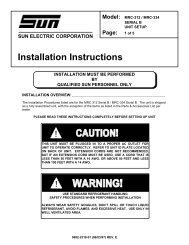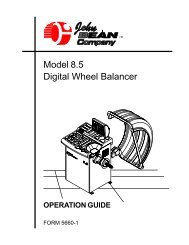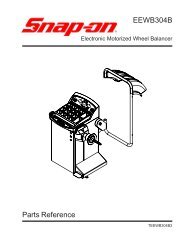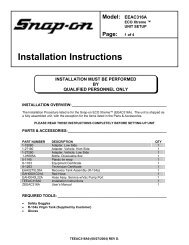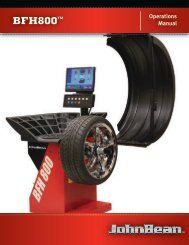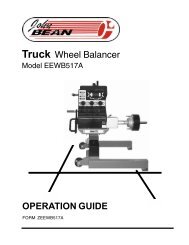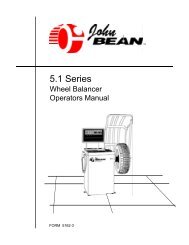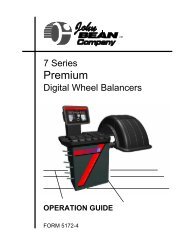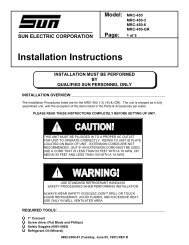Operating Instructions - Snap-on Equipment
Operating Instructions - Snap-on Equipment
Operating Instructions - Snap-on Equipment
You also want an ePaper? Increase the reach of your titles
YUMPU automatically turns print PDFs into web optimized ePapers that Google loves.
Interpretati<strong>on</strong>Data Analysis GuidelinesUse the following informati<strong>on</strong> when analyzing data to isolate a specific problem. It isimportant to remember that by-products of combusti<strong>on</strong> depend <strong>on</strong> the air-fuel ratio.Stoichiometric Air-Fuel Ratio• Lambda = 1.00 at stoichiometric air-fuel ratio.• CO and O 2 are equal at the stoichiometric air-fuel ratio.• CO 2 is an indicator of combusti<strong>on</strong> efficiency that peaks at or near thestoichiometric air-fuel ratio, and decreases with a lean or rich air-fuel ratio.• NO in the range of 1700 to 2500 ppm is typical <strong>on</strong> an engine running atstoichiometric without EGR.—With EGR, NO levels are usually between 500 and 1000 ppm.Lean Air-Fuel Ratio• Lambda is greater than 1.00. If Lambda = 1.10, this means 10% excess aircompared with stoichiometric.• High HC is an indicator of excessive leanness and misfires.• High O 2 indicates an excessively lean air-fuel ratio.• NO is highest when CO and HC are lowest.✓ Air injecti<strong>on</strong> systems should be disabled to prevent false readings.Rich Air-Fuel Ratio• Lambda is less than 1.00. If Lambda = 0.90, there is <strong>on</strong>ly 90% of the required airfor stoichiometric.• Low O 2 indicates a rich mixture.• High CO readings usually indicate a fuel mixture richer than stoichiometric.• High HC readings usually indicate excessive unburned fuel caused by lack ofigniti<strong>on</strong> or by incomplete combusti<strong>on</strong>.— Comm<strong>on</strong> causes include a faulty igniti<strong>on</strong> system, vacuum leaks and fuelmixture problemsMiscellaneous• When CO goes up, O 2 goes down.• O 2 combines with HC to form CO 2 and H 2 O.• O 2 combines with CO to form CO 2 .• O 2 and CO 2 are indicators of exhaust system integrity, sample hose and probeintegrity, or both.• O 2 is essential for proper operati<strong>on</strong> of the catalytic c<strong>on</strong>verter.— O 2 is essentially unchanged by the catalytic c<strong>on</strong>verter, providing a “window”through the catalytic c<strong>on</strong>verter to the engine.— O 2 readings are higher <strong>on</strong> vehicles with properly operating air injecti<strong>on</strong> systems.• With the air injecti<strong>on</strong> system disabled and the CO above 1%, the catalyticc<strong>on</strong>verter is O 2 starved.— Without O 2 it does not “light off,” allowing exhaust c<strong>on</strong>centrati<strong>on</strong>s to be morelike readings taken ahead of the c<strong>on</strong>verter.5-2



